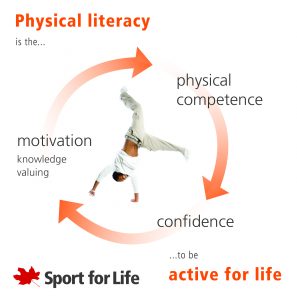Physical Literacy

Physical Literacy is the motivation, confidence, physical competence, knowledge, and understanding to value and take responsibility for engagement in physical activities for life.
~International Physical Literacy Association, May 2014
The importance of physical literacy and its role in lifelong physical activity has emerged from a series of key Canadian reports and is supported by work done by the World Health Organization (WHO).
The Canadian Sport Policy, Framework for Recreation in Canada, Common Vision for Physical Activity, and Active 2020 stress the need for physical literacy as an enabler for a healthy, happy, and successful life.
For more information on Physical Literacy, please connect with our program site at physicalliteracy.ca.
Physical education programs have been cut across the country, from elementary schools through to universities, in cost-cutting reductions. Some universities no longer offer a teaching subject in the area.
Only 42% of Ontario elementary schools have a physical education teacher – most of whom work part-time – and most elementary schools in B.C. do not have a physical education teacher.
But what happens when children aren’t receiving these quality physical education and physical activity opportunities? They don’t develop the movement repertoires that make them confident to try new activities or set them up for success in physical activity including sport. Skills like running, jumping, throwing overhand, kicking a ball, or catching aren’t developed.
Physical literacy is a critical starting point for an active lifestyle including participation in sport. Without physical competence in basic movement skills and the confidence and motivation to move, children and youth are limited in their potential for success in physical activity including sport.
Without these skills, options for activities are limited and it isn’t fun to participate. It’s much like going to a library when you can’t read. Learning fundamental movement skills in a fun, safe, and supportive environment encourages the development of physical literacy.
Canadians are not getting enough physical activity...
ONLY 9% of 5- to 17-year-olds get the 60 MINUTES of daily heart-pumping exercise that they need.
In 12- to 17-year-olds, ONLY 18% achieved at least 30 minutes of daily activity.
JUST OVER 20% of adults are meeting the Canadian Physical Activity Guidelines.
The situation is even worse among some populations groups...
Children from more disadvantaged backgrounds do not have the same opportunities for physical activity development. 17% (1.2M) of Canadian children live in low-income households.
35% of Aboriginal children and youth do not participate in sport at least once a week and 41% of Aboriginal children and youth are obese.
ONLY 3% OF GIRLS aged 12 – 17 get the recommended amount of activity.
The health effects of inactivity are costly and catastrophic...



Today’s children won’t live as long as their parents. This unprecedented change is due to an alarming decrease in physical activity, and the many diseases and health issues caused by inactivity. The estimated total health care costs of physical inactivity in Canada in 2009 was $6.8 billion.
Obesity
- Each year, up to 66, 000 Canadians die from conditions linked excess weight.
- As of 2013, roughly 65% of the Canadian population is overweight or obese.
- More than 30% of Canadian children are overweight or obese - 1 out of 3.
Type 2 diabetes
- As of 2013, 10% of Canadians have Type 2 Diabetes. That's 3.5 million Canadians who will make a total of 21 million doctor visits each year.
- By 2063 it is expected that 30% of Canadians will have Type 2 Diabetes. That will be 19.1 million Canadians who will make 115 million doctor visits!
- Type 2 Diabetes among First Nations on reserve is 4x greater than all Canadians.
Osteoporosis
- 1 in 3 women and 1 in 5 men will suffer an osteoporotic fracture during their lifetimes.
- Building strong bones during childhood is the best defence against osteoporosis. Inactivity and inadequate nutrition can impact bone density for life.
Cardiovascular disease
- Heat disease claims the life of 12 Canadian adults diagnosed with a hearth condition every hour.
- Staying active reduces your risk of heart disease.
Mental health
- Studies have shown a link between low cardiorespiratory fitness and higher depressive symptoms and lower emotional well-being compared to men and women with moderate to high cardiorespiratory fitness.
Factors Affecting Inactivity
There are many factors that contribute to inactivity levels. We live in an increasingly sedentary society, and it’s easier to avoid physical activity than it was in generations past.
In the past, our society encouraged free play. Children engaged in vigorous activity in parks and neighbourhoods where they learned movement skills from their peers. They were taught physical education by specialized teachers.

